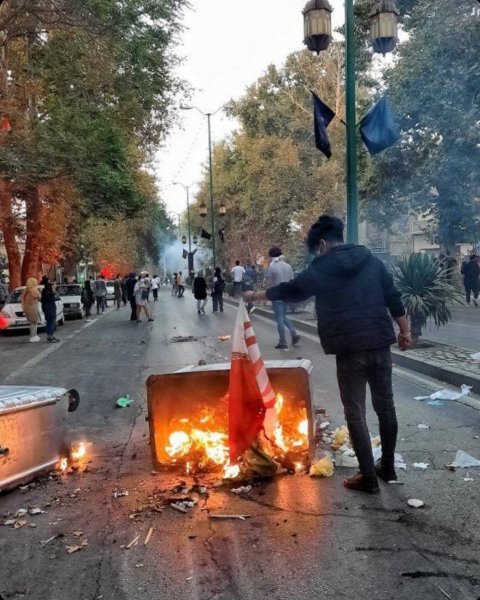Who are against Iran
Who are against Iran Recently, some principlists and revolutionary figures have declared that Iran and the Iranian flag are our red lines, claiming that street protesters who have burned the Iranian flag are against Iran and Iranians. This is while their ideological background and intellectual discourse show the opposite of their current claims.
The rooster’s tail
Mesbah Yazdi, the father of the Stability Front and part of the principlists, has repeatedly spoken against nationalism and Iran, explicitly stating that Iran without Islam is not worth sacrificing one’s life for, or that even crows and wolves defend their land and water. Mesbah Yazdi had said that if a government of disbelief ruled this country, it would no longer be worth sacrificing our lives for it.
During Ahmadinejad’s time, when Mashaei spoke of Iranianism, he said that even in the rhetoric of some officials, Islam has been replaced by Iranianism and nationalism, which is the same slogan that the Shah raised as positive nationalism.
Or he said, I never believed that one of the statesmen of the Islamic system would explicitly say that America’s hostility is not because of the system but because of Iran or Iranianism, which means turning one’s back on all divine and human values, similar to Trump’s behavior who hugs and kisses the American flag, showing that human rights, peace, and similar concepts, even based on their own interpretation, hold no value for them.
What is important is America. Unfortunately, today, the dominant culture in the world and even in Islamic countries is the preservation of geographical borders, which has caused divisions among Muslims.
Meisam Latifi, Raisi’s deputy, also recently stated that in governance, a set of theories should be employed, explicitly rejecting the nation-state theory and replacing it with the Imam-Ummah theory. Sometimes we use good theories, but what should happen in practice doesn’t happen.
Contrary to the Western model that defines governance based on the Nation State, fundamentally, we have a problem with this, and our issue is with the Imam and the Ummah. Our theory is the theory of brotherhood, the theory of responsibility, our theory is the theory of enjoining good and forbidding wrong. These theories are not an additional phenomenon; they are foundational theories, a duty. God willing, these foundations will certainly be presented to new students participating in this course.
The theory of Umm al-Qura
Apart from these statements, in the foreign policy of the Islamic Republic, there is a theory called the theory of Umm al-Qura, meaning the mother of villages, to explain the foreign policy guidelines and analyze the power boundaries of the Islamic Republic of Iran, which was proposed three decades ago by Mohammad Javad Larijani.
According to the proponents of this theory, Iran, after the revolution, has taken the leadership position of Umm al-Qura, and the government of Iran must address not only national interests but also the interests of the Islamic world. Other countries are also obliged to support and defend Iran as the Umm al-Qura of the Islamic world. In case of a conflict between the interests of Umm al-Qura and the interests of the Ummah, the interests of the Ummah always take precedence unless the issue is about preserving the Islamic system in Umm al-Qura.
Behind the scenes
The Crisis Management and Emergency Situations Quarterly, published by Imam Hussein University, in one of its issues, examined and analyzed the functions of psychological operations in controlling protest actions and crisis gatherings, writing that the results showed that, according to experts, commanders, and NAJA personnel, by systematically and premeditatedly using psychological operations, protest actions and gatherings can be controlled. In this article, various methods of psychological operations are categorized and prioritized in terms of their effectiveness in controlling gatherings, which include, in order:
The rumor of infiltrators among the protesters, spreading rumors of the arrest of protest group leaders, persuasion and negotiation with protesters, trivializing the demands of protesters, exposing the dependency of protest group leaders, creating scapegoats, sacrificing some of their own elements, creating new news centers, using infiltrators among protesters, sympathizing with protesters, disarming them psychologically, extracting confessions from protest group leaders, intimidating protesters, deceiving protest groups, and ridiculing the demands of protesters.
It seems that exaggerating the issue of flag burning is also part of this category, to the extent that a Twitter user, by publishing images of tweets from Hossein Saremi, a valuable and revolutionary media activist, has questioned whether it is very normal for Hossein Saremi to constantly be in the same place with someone who burns the Iranian flag, and it is very natural that the image of Sina Hasani, who was arrested in Urmia, is introduced as the person who burned the flag in Tehran. Mr. Islamic Republic, with such individuals, do you expect anyone to believe your words?
Vahid Ashtari, a justice-seeking media activist and the person who first publicized the story of Ghalibaf’s ‘Sismoni Gate’ and was sentenced to prison for it, wrote under this tweet: ‘One day he said I accidentally saw him burning the flag and filmed him. A few days later, he said the security guys arrested him and gave him a hard time. Again last night, he accidentally saw the guy burning the flag and filmed him.’
Another user, by republishing two tweets from Hossein Saremi, who claimed to have caught the same teenager twice burning the Iranian flag and filmed him, wrote: ‘If the prosecutor was a prosecutor, he should have arrested this poor guy for burning the flag. He’s hired a teenager to burn flags for him in different parts of the city.’

